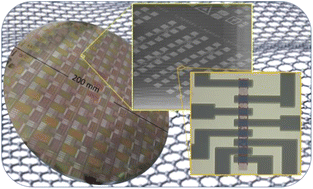Reliable metal–graphene contact formation process flows in a CMOS-compatible environment
Abstract
The possibility of exploiting the enormous potential of graphene for microelectronics and photonics must go through the optimization of the graphene–metal contact. Achieving low contact resistance is essential for the consideration of graphene as a candidate material for electronic and photonic devices. This work has been carried out in an 8′′ wafer pilot-line for the integration of graphene into a CMOS environment. The main focus is to study the impact of the patterning of graphene and passivation on metal–graphene contact resistance. The latter is measured by means of transmission line measurement (TLM) with several contact designs. The presented approaches enable reproducible formation of contact resistivity as low as 660 Ω μm with a sheet resistance of 1.8 kΩ/□ by proper graphene patterning, passivation of the channel and a post-processing treatment such as annealing.



 Please wait while we load your content...
Please wait while we load your content...